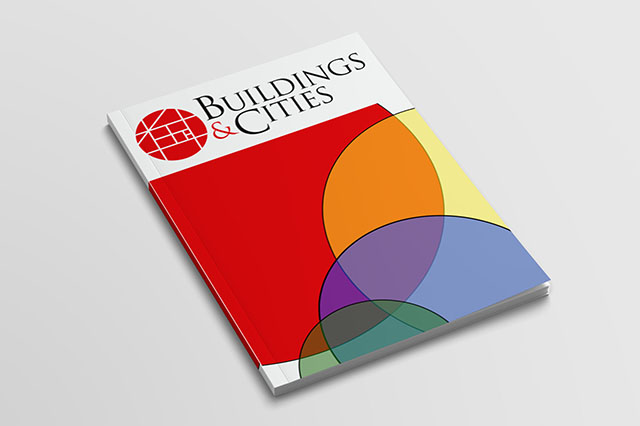
www.buildingsandcities.org/insights/news/welcome.html
Welcome to Buildings and Cities

It is our pleasure to welcome you to the Buildings and Cities journal. We are created by and for the research community that we serve. Our emphasis is on creating, supporting and maintaining a vibrant global and inclusive community of authors and readers.
Our content is diverse and cross-disciplinary. Buildings and Cities considers the interplay and interactions between the different scales of region, city, building stocks, neighbourhood, street or block, and the individual site / building. We also address fragmentation - of disciplinary boundaries and responsibilities, regulation and governance, research and practice.
Understanding how these elements interact is critical for meeting the current challenges we face in policy and practice. We will bring additional content to you - briefing papers, synthesis articles, policy analysis, replication articles, methods articles, commentaries, book reviews.
We're innovative. We will actively encourage engagement with the end users of research - policy makers, practitioners, clients and wider society. We recognise that the dialogue must be two-way to be meaningful. In addition to content on our website, we will partner with organisations to host events to discuss research needs, research findings and the actions that need to arise.
We're launching this journal to respond to the multiple crises and challenges facing the built environment. First and foremost are the challenges in our towns, cities and peri-urban areas to create a built environment that supports human development and ecological systems and reduces resource demand and GHG emissions. Places that are safe, healthy, inclusive, sustainable and adaptable over time. A built environment that mitigates climate change and makes a positive contribution to global and local vitality. The professional responsibilities owed to society are shifting; consequently education, training, skills and organisational practices need to respond.
The editors have a proven reputation for providing a rigorous, high-quality peer-review process for journal articles and curated themed issues. Our previous success at Building Research & Information shows what we can deliver with confidence. We use a double-blind peer review system with a minimum of 3 expert reviewers. Our editors advise and assist authors with the feedback they receive.
We recognise the enormous contribution that authors, reviewers and editors contribute to this journal - so we don't exploit authors' and reviewers' work by extracting a profit. Any surplus will go into the journal or back into the research community as small grants or financial assistance for publishing. We're independent from large publishers who impose strictures on their journals and editors. As a not-for-profit organisation, we are not motivated to publish more and more to benefit shareholders (we have no shareholders).
You are invited to participate in this active community and contribute your research and insights. We will encourage a two-way dialogue and exchange with practitioners, clients, policy makers and the public.

Richard Lorch,
Editor in Chief
Latest Peer-Reviewed Journal Content
Living labs: epistemic modelling, temporariness and land value
J Clossick, T Khonsari & U Steven
Co-creating interventions to prevent mosquito-borne disease transmission in hospitals
O Sloan Wood, E Lupenza, D M Agnello, J B Knudsen, M Msellem, K L Schiøler & F Saleh
Circularity at the neighbourhood scale: co-creative living lab lessons
J Honsa, A Versele, T Van de Kerckhove & C Piccardo
Positive energy districts and energy communities: how living labs create value
E Malakhatka, O Shafqat, A Sandoff & L Thuvander
Built environment governance and professionalism: the end of laissez-faire (again)
S Foxell
Co-creating justice in housing energy transitions through energy living labs
D Ricci, C Leiwakabessy, S van Wieringen, P de Koning & T Konstantinou
HVAC characterisation of existing Canadian buildings for decarbonisation retrofit identification
J Adebisi & J J McArthur
Simulation and the building performance gap [editorial]
M Donn
Developing criteria for effective building-sector commitments in nationally determined contributions
P Graham, K McFarlane & M Taheri
Reimagining circularity: actions for optimising the use of existing buildings
R Lundgren, R Kyrö, S Toivonen & L Tähtinen
Effective interdisciplinary stakeholder engagement in net zero building design
S Vakeva-Baird, F Tahmasebi, JJ Williams & D Mumovic
Metrics for building component disassembly potential: a practical framework
H Järvelä, A Lehto, T Pirilä & M Kuittinen
The unfitness of dwellings: why spatial and conceptual boundaries matter
E Nisonen, D Milián Bernal & S Pelsmakers
Environmental variables and air quality: implications for planning and public health
H Itzhak-Ben-Shalom, T Saroglou, V Multanen, A Vanunu, A Karnieli, D Katoshevski, N Davidovitch & I A Meir
Exploring diverse drivers behind hybrid heating solutions
S Kilpeläinen, S Pelsmakers, R Castaño-Rosa & M-S Miettinen
Urban rooms and the expanded ecology of urban living labs
E Akbil & C Butterworth
Living with extreme heat: perceptions and experiences
L King & C Demski
A systemic decision-making model for energy retrofits
C Schünemann, M Dshemuchadse & S Scherbaum
Modelling site-specific outdoor temperature for buildings in urban environments
K Cebrat, J Narożny, M Baborska-Narożny & M Smektała
Understanding shading through home-use experience, measurement and modelling
M Baborska-Narożny, K Bandurski, & M Grudzińska
Building performance simulation for sensemaking in architectural pedagogy
M Bohm
Beyond the building: governance challenges in social housing retrofit
H Charles
Heat stress in social housing districts: tree cover–built form interaction
C Lopez-Ordoñez, E Garcia-Nevado, H Coch & M Morganti
An observational analysis of shade-related pedestrian activity
M Levenson, D Pearlmutter & O Aleksandrowicz
Learning to sail a building: a people-first approach to retrofit
B Bordass, R Pender, K Steele & A Graham
Market transformations: gas conversion as a blueprint for net zero retrofit
A Gillich
Resistance against zero-emission neighbourhood infrastructuring: key lessons from Norway
T Berker & R Woods
Megatrends and weak signals shaping future real estate
S Toivonen
A strategic niche management framework to scale deep energy retrofits
T H King & M Jemtrud
Generative AI: reconfiguring supervision and doctoral research
P Boyd & D Harding
Exploring interactions between shading and view using visual difference prediction
S Wasilewski & M Andersen
How urban green infrastructure contributes to carbon neutrality [briefing note]
R Hautamäki, L Kulmala, M Ariluoma & L Järvi
Implementing and operating net zero buildings in South Africa
R Terblanche, C May & J Steward
Quantifying inter-dwelling air exchanges during fan pressurisation tests
D Glew, F Thomas, D Miles-Shenton & J Parker
Western Asian and Northern African residential building stocks: archetype analysis
S Akin, A Eghbali, C Nwagwu & E Hertwich


Latest Commentaries
Building-Related Research: New Context, New Challenges
Raymond J. Cole (University of British Columbia) reflects on the key challenges raised in the 34 commissioned essays for Buildings & Cities 5th anniversary. Not only are key research issues identified, but the consequences of changing contexts for conducting research and tailoring its influence on society are highlighted as key areas of action.
Lessons from Disaster Recovery: Build Better Before
Mary C. Comerio (University of California, Berkeley) explains why disaster recovery must begin well before a disaster occurs. The goal is to reduce the potential for damage beforehand by making housing delivery (e.g. capabilities and the physical, technical and institutional infrastructures) both more resilient and more capable of building back after disasters.